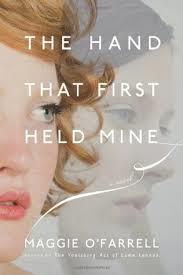When I first opened “The Hand that First Held Mine” by Maggie O’Farrell, I thought I was diving into two separate stories. But as I kept turning the pages, something magical happened—the lines between past and present began to shimmer and blur, weaving the lives of two women across decades into one unforgettable tapestry.
In the late 1950s, I met Lexie Sinclair, a firecracker of a woman who boldly leaves behind the quiet hush of her Devonshire upbringing for the raw energy of London. Lexie isn’t just chasing a dream—she’s charging toward it. She falls for the irresistibly charming Innes Kent, an editor who introduces her to a life brimming with art, culture, journalism, and the smoky glamour of Soho nights. I followed her as she carved out a space for herself—not just in a man’s world but in her own dazzling orbit.
Fast forward to the present day, and I was suddenly walking beside Elina, a gifted artist who has just survived a traumatic C-section. She’s foggy, fragile, and fierce all at once, struggling to hold herself together as a new mother while trying to grasp the enormity of what just happened. Her partner, Ted, is doing his best, but he’s also unraveling—haunted by something he can’t quite remember, a truth that teeters just out of reach.
At first, the two timelines felt like parallel trains speeding in opposite directions. But slowly, subtly, threads began to appear, drawing connections between the lives of these women. Both Lexie and Elina are deeply immersed in the art world. Both face the chaotic beauty and terror of motherhood. And both are propelled by a fierce love for their children and a quiet yearning to find themselves again amidst the disarray.
What truly amazed me was how O’Farrell stitches these lives together with a kind of literary sleight-of-hand. Through Ted’s haunting flashbacks, the past peeks into the present like sunlight through cracks in a door. I found myself mesmerized by these moments—like when Innes Kent’s old magazine office resurfaces, now reborn as a trendy café that Ted visits fifty years later. Time folds in on itself so organically, it gave me goosebumps.
O’Farrell’s writing is a marvel. She paints ordinary scenes with extraordinary depth, giving breath and weight to the tiniest gestures and thoughts. Her characters—especially Lexie and Elina—feel so real, I found myself rooting for them, grieving with them, and pausing just to admire their grit. And her portrayal of early motherhood, particularly Elina’s raw, unfiltered experience, left me breathless. It’s rare to find such honesty, such aching beauty in words.
She plays with grammar and tense like a jazz musician riffing on a melody—breaking the rules just enough to create something hypnotic and bold. I never quite knew where the story would take me, but I was hooked, completely under her spell.
With this novel, Maggie O’Farrell proves once again why she’s a master of emotional resonance and intricate storytelling. “The Hand that First Held Mine” isn’t just a book—it’s an emotional time machine, a soulful reflection on memory, identity, and the invisible threads that bind us all.
*









Add comment